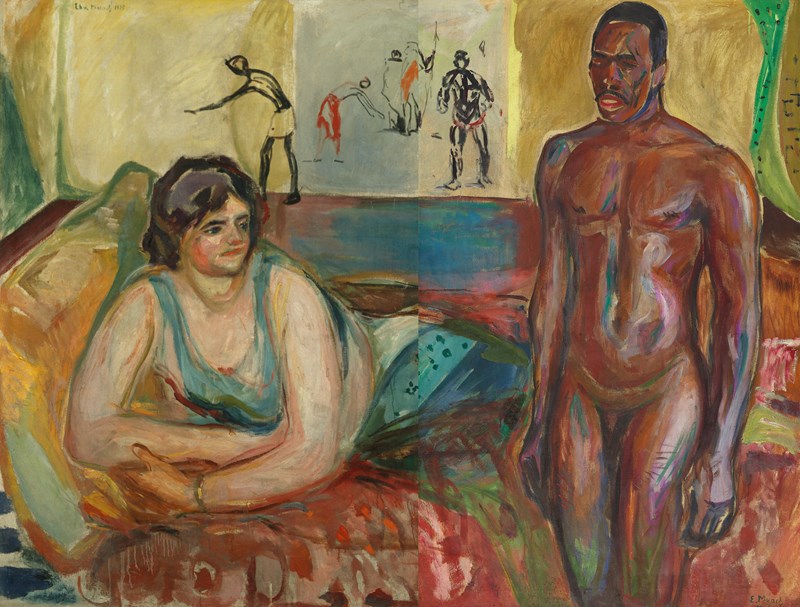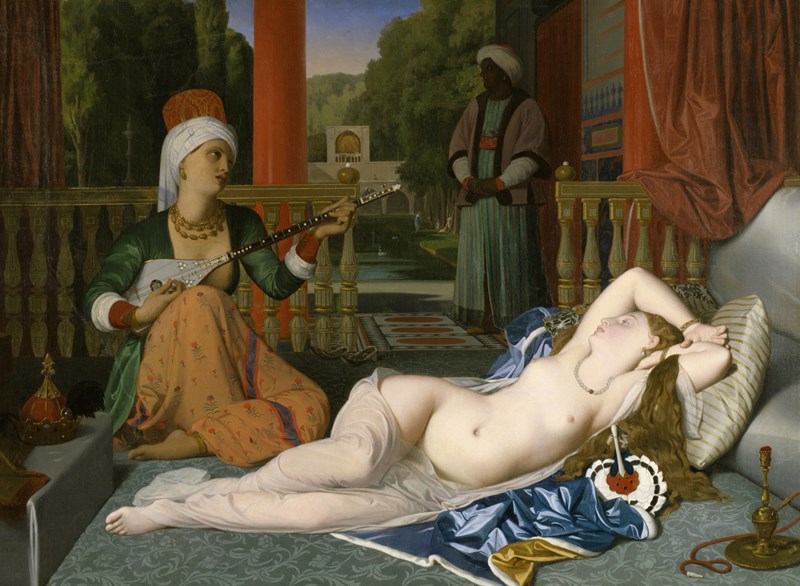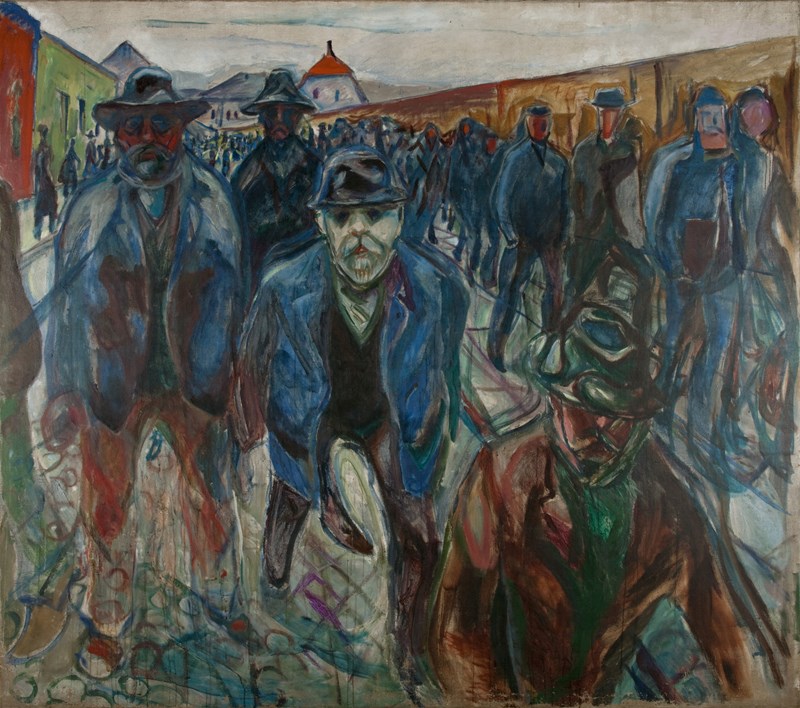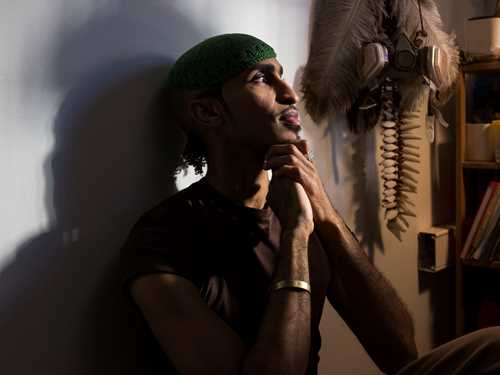Edvard Munch and the History of Slavery
Edvard Munch’s painting Cleopatra and the Slave can be understood as a reflection on the history of slavery and this history’s significance for the notion of race.

Edvard Munch: Cleopatra and the Slave. Oil on canvas, 1916. Photo © Munchmuseet
A work of art is rarely unambiguous, yet some artworks provide a more abundant basis for interpretations than others. Munch’s painting Cleopatra and the Slave from 1916 is such a work. In the painting, Edvard Munch depicts an athletic male of African origin next to a fair-skinned, scantily dressed woman. When considered as a motif, the title Cleopatra and the Slave first brings to mind Cleopatra VII Philopator and the complex history of slavery in Ancient Egypt. It is reasonable to interpret the slave figure as one of Egypt’s many Nubian prisoners of war, that is to say East Africans from the region that today generally coincides with Sudan. Nubian prisoners of war were largely enslaved in the courts of the Pharaohs.
Cleopatra is considered to be the last Pharaoh of Ancient Egypt. She was queen of the Greek Macedonian dynasty that ruled Egypt from the years 323 to 30 BCE. In Munch’s painting she is represented as a white Nordic woman in modern attire, rather than a more historically correct depiction of her as Macedonian. This representation calls to mind the history of modern slavery as it developed from the 18th century onward.
Unlike modern slavery, the slavery of Ancient Egypt was not founded on ethnicity or notions of race. The labouring figures in the painting’s background may be understood in view of this fact. With their loincloths, the uniform stick figures are reminiscent of the figures one finds in Ancient Egyptian art. One of the figures is black, while the others are white. The motif can thus give rise to reflections around notions about race and associations with the history of slavery.
Sexual Tensions
Cleopatra and the Slave may call to mind oriental motifs in European art from the 19th century, such as Jean-Auguste-Dominique Ingres’ painting Odalisque with Slave from 1839.

Jean-Auguste-Dominique Ingres: Odalisque with Slave. Oil on canvas, 1842. Walters Art Museum. Acquired by Henry Walters, 1925.
Dagbladet’s critic Jappe Nilssen refers to this when he discusses the painting in connection with Munch’s exhibition at Blomqvist in 1921. He interpreted the reclining female figure as an odalisque, rather than seeing her in keeping with the painting’s title. An odalisque was a female sex slave, often belonging to the Sultan’s harem. The harem’s male slaves were traditionally eunuchs, castrated men imported from East Africa. This type of motif is often based on stereotypical Western fantasies, or notions, regarding the so-called Orient – what we call the Middle East and Asia today.
By interpreting the female figure in Cleopatra and the Slave in this manner, the motif gains a sexual connotation via the odalisque’s role as a sex slave. According to Nilssen, the representation of “the odalisque and the naked bestial negro” was both potent and bold. In other words he seems to be preoccupied with a sexual tension between the woman and the man in the motif. This is underscored by Nilssen’s description of the slave figure. The caricatured male figure in the background amplifies this association. The figure resembles the stereotypical notions of African men in the popular culture of the time as muscular, wearing a loincloth and wielding a shield and spear.
When Nilssen described Cleopatra and the Slave as a bold work, it may also be understood in view of contemporary notions of sexual relations across ethnic lines. Men of African origin were often seen as extremely virile and potent, but equally as a threat to the European male’s sexuality and masculinity. In 1935 the French writer Henry Champly warned European men that the so-called “Coloured races have discovered your supreme treasure, the White Woman.” According to the writer, such sexual relations across ethnic lines might lead, in a worst-case scenario, to the demise of “the white race”.
It is possible Munch drew upon these stereotypical notions when he depicted Cleopatra as a fair-skinned Nordic woman rather than as a more historically correct representation of her as Macedonian. Nilssen may have also insinuated this when he compared the African model with the men in Workers on Their Way Home, which was displayed opposite Cleopatra and the Slave in the exhibition at Blomqvist.

Edvard Munch: Workers on their Way Home. Oil on canvas, 1913-1914. Photo © Munchmuseet
Compared to the “savage” African, the modern-day workers gave the impression of being “tired, weary men”, he pointed out. It’s almost as though he anticipated Champly’s cultural critique, where the modern, civilised white man falls short when compared to the so-called primitive man’s sexual superiority.
Fantasies about Primitive Peoples
Notions of this kind about non-Western peoples were common during Munch’s time. Based on evolutionary ideas, so-called “primitive people” were not only considered less developed in a social and cultural sense, their sexuality was also viewed as primitive, in the sense that it illustrated sexuality’s irrational and animalistic origins.
I 1913 the psychiatrist Sigmund Freud published the significant book Totem and Taboo, which can by and large be read as an attempt to explain the origins of civilisation via humankind’s control of sexuality. According to Freud, the primitive phase in the sexual development of humanity consisted of “a necessary phase in the development of all races”. Freud’s ideas were further developed in numerous ethnographic studies in the early 20th century, among others by the Polish anthropologist Bronislaw Malinowski, who conducted field studies among the indigenous people of Papua New Guinea. In his book The Sexual Life of Savages from 1929, he claimed that by studying the sexual practices of “primitive people” one could gain universally applicable insights into the development of humanity.
These attitudes were also expressed in the art of the period. Towards the end of the 19th century a number of European artists began to show an interest in non-Western cultures, a phenomenon that was largely due to conquests made by the colonial powers. Artefacts from Africa, Polynesia, Micronesia and America became charged with romantic, and even racist, fantasies about cultures and peoples with “unspoiled”, “uncivilised” and “primitive” traits. By the early 20th century African sculpture became a subject of great interest among European artists, such as Pablo Picasso and Ernst Ludwig Kirchner. It is quite possible that Munch was likewise inspired by such sculptures. The slave figure’s stiff and erect posture in Cleopatra and the Slave may resemble classical Congolese sculpture. Munch had the opportunity to see sculptures of this kind at the Ethnographic Museum in Oslo, where an acquaintance from his youth, Inge Heiberg, had donated a large collection of Congolese art in 1902.
What typified the interest in these artefacts was the pursuit of a primitive order, a kind of utopian pre-modern condition in which human beings were in harmony with themselves and nature. This ideal was articulated in 1894, when the German critic Franz Servaes claimed that Munch was endowed with a special visionary and genuine connection to mankind’s primitive origins. Paul Guaguin moved to Tahiti during the 1890s in search of an authentic and simple past, but according to Servaes it was not necessary for Munch to resort to such drastic steps: “Munch has no need to travel to Tahiti to discover the primitive traits in human nature, he carries his own Tahiti within himself”, wrote Servaes.
An Allegory on the History of Slavery
We do not know a lot about the model behind the slave figure in Cleopatra and the Slave. Yet the little we know about him and his work as a circus artist has significance for our interpretation of Munch’s motif. The man was part of the German Circus Hagenbeck troupe, which visited Oslo in 1916. According to a promotional card for the circus, his artist name was Sultan Abdul Karem. We also presumably know something about his line of work in the circus. An article in Morgenbladet from 1916, states that the circus presented an act featuring a “negro” and a group of “mamluk Arabs”. We can assume that the former was Sultan Abdul Karem, because Mamluks were known to serve as private guards to sultans during the Muslim Ayyubid dynasty in the 12th and 13th centuries. The seat of the dynasty was in Cairo, but was governed by a number of regional princes, or sultans. We can therefore assume that Sultan Abdul Karem participated in Circus Hagenbeck’s many ethnographic and semi-historical performances of various ethnic groups and cultures. The circus was among Europe’s largest, and had specialised, among other things, in displaying exotic animals and humans from foreign lands. These performances largely drew on colonial, and sometimes racist, notions of so-called “primitive” and “exotic” peoples. This was underscored by Morgenbladet’s journalist, who described the group as “a howling tribe.”
According to the diary kept by Munch’s relative Ludvig Ravensberg, Munch had spent several evenings at Circus Hagenbeck. In other words, there is good reason to assume that Munch was familiar with the act described in Morgenbladet. In keeping with the motif’s historical connotations, implied in part by its title, Sultan Abdul Karem’s role at the circus opens for a more ambiguous interpretation of Cleopatra and the Slave. In the circus act, he implicitly embodied the role of slave owner. The term mamluk originally comes from Arabic and denotes something that is owned. The Mamluks, in other words, were enslaved soldiers during the Ayyubid dynasty. Since one could not enslave Muslims according to Islamic law, these soldier slaves were largely imported from the Caucasus. If we recall Jappe Nilssen’s interpretation of the female figure as an odalisque, a paradox arises. The Sultans’ odalisques were also mostly imported from the Caucasus, in addition to Greece and Macedonia.
This might explain the depiction of Cleopatra as a blonde Northern European woman in modern attire. The American historian Nell Irvin Painter has pointed out that the idea of the white, or so-called Caucasian, race is closely linked to anthropological notions – as they were developed during the 18th century – that Northern European peoples originally came from the Caucasus. Based on the European ideals of beauty from that period, the idea of the presumed superiority of the European race was rooted in anatomical observations and skull measurements. These theories became the basis for the development of physiological anthropology as a scientific discipline, which would later lay the groundwork for scientific racism, as it developed in Europe during the 19th and 20th centuries. According to this scientific discipline, people of different ethnic background were categorised according to the idea of human races, and ranked according to their alleged mental, intellectual and cultural development. Scientific racism laid the groundwork for the development of modern race ideology, in which the so-called Caucasian race was considered superior to other races. This would have great significance for the European colonial powers’ justification for the trans-Atlantic slave trade.
Paradoxically, the concept of the Caucasian race’s beauty is, according to Painter, closely tied to romantic and orientalist notions of the so-called white slave trade and its connection with the Caucasus – as it was expressed among other things via the depiction of the fair-skinned, young and beautiful odalisque’s position in the Ottoman harems. Painter’s argument points back to Nilssen’s interpretation of the female figure in Cleopatra and the Slave as an odalisque. In keeping with this interpretation, it is not only the African male figure that appears as a slave in the motif, but the light-skinned European woman as well. At the same time, by virtue of their respective roles as pharaoh and sultan, they may also be considered slave owners. Munch’s motif may therefore be understood as an allegory on the history of slavery, and thus opens up to a number of conundrums regarding the complexity of this history. The allegory points not least to the history’s close association with the idea that humans can be categorised according to race – and that some races are superior to others.
Sources:
Ames, Eric. Carl Hagenbeck’s Empire of Entertainments. Mclellan Books. 2009.
Champly, Henry. White Women, Coloured Men. Warre Bradley Wells (transl). J. Long. 1936.
Chang, Alison W. “Staging Ethnicity: Edvard Munch’s Images of Sultan Abdul Karem”. In: Adrienne L. Childs and Susan H. Libby (Eds.). Blacks and Blackness in European Art and the Long Nineteenth Century. Ashgate Publishing. 2014.
Meier-Graefe, Julius. Modern Art: Being a Contribution to a New System of Æsthetics. Florence Simmonds and George W. Chrystal (transl.). William Heinemann. 1908.
Morgenbladet. 14.10.1916.
Nilssen, Jappe. “Edvard Munch”. Dagbladet. 19.1.1921.
Painter, Nell Irvin. The History of White People. W. W. Norton and Co. 2010.
Ravensberg, Ludvig. Diary. 28.11.1916 and 30.11.1916.
Rothfels, Nigel. Savages and Beasts: The Birth of the Modern Zoo. Johns Hopkins University Press. 2002. Servaes, Franz. Untitled essay. In: Stanislaw Przybyszewski (Ed.). Das Werk des Edvard Munch: Vier Beiträge. S. Fischer Verlag. 1894.
![Edvard Munch: [Title under consideration]. Oil on canvas, 1916. Photo © Munchmuseet](/globalassets/kunstverk/title.jpg?w=500&h=333&mode=Crop&quality=50&crop=0,56,2173,1504)
![Edvard Munch: [Title under consideration]. Oil on canvas, 1916. Photo © Munchmuseet](/globalassets/kunstverk/tittel-til-vurdreing.jpg?w=500&h=333&mode=Crop&quality=50&crop=0,507,2154,1943)


